Laptop Mag Verdict
This 10-inch rugged tablet offers field-workers epic battery life and a bright display, although the keyboard might be too cramped for some users.
Pros
- +
Lightweight for a rugged notebook
- +
Long battery life
- +
Responsive touchscreen
- +
Bright display with good viewing angles
- +
Better graphics performance than other fully rugged notebooks
- +
Strong wireless scores
Cons
- -
Cramped keyboard
- -
Touchpad has a lot of friction
Why you can trust Laptop Mag
Rugged laptops typically involve a few compromises: If you get a screen large enough to work comfortably for hours or watch movies, you'll have to lug seven or eight pounds around. Smaller models are lighter, but their keyboards are cramped. The 10-inch Panasonic Toughbook 19, a small rugged tablet that costs $4,344, falls in the latter category. But while this machine is inherently imperfect from an ergonomic standpoint, it still bears an impressive nearly 8 hours of battery life and a bright touchscreen display.
Design
The design of the Toughbook 19 hasn't changed since we last reviewed it more than a year ago. The silver, magnesium alloy chassis has Panasonic's logo stamped prominently on the lid and black bumpers on the sides. (Inside, the keyboard, deck, and touch buttons are black, too; the palm rest and bezel are silver.) Because the screen is just 10.4 inches, the notebook weighs a portable 5 pounds (13- and 14-inch ruggeds run in the 7- to 8-pound range), and has a carrying handle, too. Even without the handle, the Toughbook 19 is relatively small, 10.7 x 8.5 x 1.9-inch frame made it easy to carry.
On the sides, all of the ports are sealed, making this rugged notebook dust-resistant, in addition to water- and vibration-resistant. The ports include: two USB 2.0, two external antenna connectors, serial and FireWire, external video, a port replicator, Ethernet and modem jacks, and headphone and mic. The Toughbook 19 also has a PC Card Type II slot, an ExpressCard/54 slot, and an SD Card reader. Our unit had no webcam, although a 2-MP camera with autofocus and dual LED flash is optional ($300). Annoyingly, because of the gasketing, the ports don't fit on the sides; some key openings, including a USB port, are in the back.
Keyboard and Touchpad
In terms of the layout, the Toughbook 19's spill-resistant keyboard looks like it was ripped from a first-generation netbook: it's cramped, and some keys are shrunken or--worse--misplaced. We never got comfortable writing e-mails or anything else longer than a few characters; we typed gingerly so as not to hit the wrong key by mistake. Searching for the undersized tab and question mark keys slowed down typing, and the arrow keys are arranged in a frustrating L shape, with the right and left arrow keys next to each other, and the up and down keys stacked adjacent to them. For $250 you can add backlighting to the keyboard.
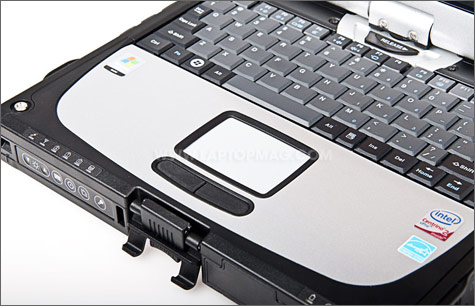
Click to enlarge
As wide as the palm rest is, the touchpad is still small, at 2.3 x 1.5 inches; that's barely larger than those on netbooks, such as the Samsung N110. Although the touchpad is large enough for dragging the cursor across the screen, we though it had too much friction. To boot, the rubbery touch buttons are too small and stiff.
Display and Sound
The screen on the Toughbook 19 has a brightness level of 500 nits when you use it like a laptop, which
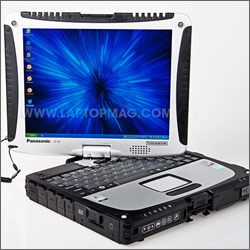
Click to enlargedoubles to 1,000 nits when in tablet mode. The wide range is meant to accommodate many lighting conditions, from weak natural light to lots of sun glare.
Indeed, the Toughbook 19's display was stunning. The 10.4-inch screen is so vibrant that even our co-workers stopped by our work area to comment on its brightness. Its matte finish makes for a versatile range of viewing angles, which is precisely what mobile professionals working in the field require. The default resolution (1024 x 768) might be too fine for some viewers; we, at least, didn't enjoy staring at it for extended periods of time.
The speaker (there's only one), built into the lower right corner of the bezel, produces surprisingly loud audio, but it's tinny.
Tablet Performance
When we flipped the convertible screen back into tablet mode, it felt sturdy as we carried it. The stylus comes attached to the chassis with a springy cord. Even if you don't touch the display, the buttons, links, and other on-screen objects will appear highlighted when you hover just over the surface. The Toughbook 19 responded to even the slightest taps, and we were able to write on-screen as if we were holding a pen. Right-clicking involves holding down the tip of the pen. We occasionally had to double-tap multiple times to get it right, but most of the time this equivalent of double-clicking worked well.
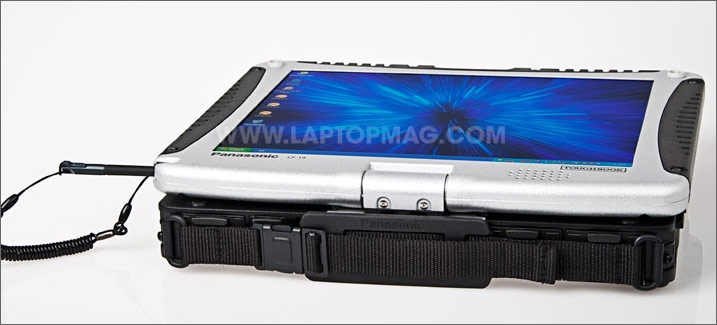
Click to enlarge
Whereas many tablets have handwriting software that hovers on the side of the desktop, ready to take notes at a moment's notice, with the Toughbook 19 it pops up when needed, such as entering words into a search engine. The tablet also has Windows Journal software, which allows you to write on full-screen "notebook sheets." In both cases, the software recognized our handwriting well, regardless of whether we wrote in print or script. However, Windows Journal makes it difficult to highlight words to convert to text in a neat box; we often mistakenly highlighted some words, leaving others out.
Durability
In addition to the magnesium alloy chassis and sealed ports, the Toughbook 19 includes a shock-mounted hard drive and display. The 160GB hard drive is also easily removable, in case of an emergency. The Toughbook 19 can also withstand three-foot drops with the screen open. When Panasonic conducts this test, in accordance with the military's drop test (MIL-STD-810F, Method 516.5), it drops it onto a two-inch sheet of plywood, which lies atop a sheet of steel, which in turn lies over concrete.
This system also passes the military spray test (MIL-STD-810F, Method 506.4), meaning it can withstand wind blowing at 40 miles per hour with the unit on and open but the ports closed.
Additionally, per MIL-STD-810F Methods 501.4 and 502.4, the Toughbook 19 can withstand temperatures between -20 and 140 degrees Fahrenheit (-60 to 160 degrees with the machine turned off). The Toughbook 19 can also operate at altitudes as high as 15,000 feet, per the military's altitude test (MIL-STD-810F, Method 500.4).
Security Features
In addition to being physically impenetrable, the Toughbook 19 offers some key security features: TPM v1.2 circuitry, Intel's vPro technology for easier remote management, Computrace theft protection built into the BIOS, a cable lock slot, and an optional fingerprint ($150 to 200, depending on the configuration) and Smart Card reader ($250).
New with this iteration is a concealed mode, which allows users to turn off all lights on the machine--including the display and LEDs--by pressing a function key. Users can also customize which lights get turned off. This is ideal for military and law enforcement use, for those times when you don't want your laptop's lights to give away your position.
Performance
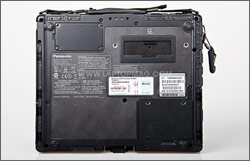
Click to enlarge
Our unit had a 1.2-GHz Intel Core 2 Duo SU9300 CPU, 4GB of RAM, and Windows XP Tablet PC Edition. It scored 2,885 on PCMark Vantage, which is just 60 points higher than the thin-and-light category average. Moreover, the Toughbook 19's 160GB, 5,400-rpm hard drive transferred 4.97GB of mixed media files at a rate of 18.8 MBps, whereas the Getac B300, a larger 13-inch system with a 120GB, 5,400-rpm hard drive, notched only 15.7 MBps; on average, a thin-and-light notebook manages only 17.9 MBps.
The Toughbook 19 felt plenty fast in our testing. It booted in 56 seconds, which is right in line with other XP systems. We also had no problem navigating among various tabs in Internet Explorer, reading e-mail, downloading attachments, perusing documents stored in an ftp server, and downloading Handbrake, an open-source media converter. Although it has a fanless design, the notebook didn't feel hot while we used it.
Graphics
The Toughbook 19's graphics aren't as powerful as a traditional thin-and-light notebook, which you might use for both work and play, but they do trump the B300, despite the fact that it has a larger display. The Toughbook 19 scored 1,937 and 806 on 3DMark03 and 3DMark06, respectively, whereas the B300 only managed 1,585 and 550. Compared with the average thin-and-light, however, these scores are low; the category averages for these two benchmarks are 2,738 and 1,227, respectively.
Battery Life and Wi-Fi
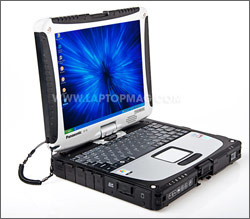
Click to enlarge
The Toughbook 19's six-cell battery lasted an impressive 7 hours and 45 minutes on the LAPTOP Battery Test, making this notebook a great choice for field-workers. The last generation CF-19, as it was called then, lasted five 5 hours and 29 minutes with Wi-Fi on, albeit with a different battery test.
Its Intel WiFi Link 5100 a/b/g/n radio delivered throughput of 20.2 Mbps and 18.2 Mbps at 15 and 50 feet, respectively. That's right in line with the B300, and is better than the average for the thin-and-light weight category, too. The Toughbook also has Bluetooth. You can also upgrade to Gobi Technology (EV-DO Rev. A, HSPA) for $250 and install a GPS receiver ($450).
Configuration Options
When it comes to configurability, the Toughbook 19's specs are fairly rigid. There's only one CPU option; although 2GB of RAM is standard, you can upgrade to 4GB ($195). If you don't want the standard 160GB hard drive, your only other choice is a 32GB solid state drive ($1,099).
Software and Warranty
As any business notebook should, the Toughbook 19 has a bare-bones look, and is devoid of bundled trial software. It comes with a three-year warranty, which is standard for a business notebook. The service includes 24/7, toll-free phone support and overnight delivery to and from the repair depot, when necessary.
The Verdict
As a fully rugged 10-inch notebook, the Panasonic Toughbook 19 occupies a class all its own. If you want a military-grade notebook that will last the whole day and won't break your back--and you have the room in your budget--the Toughbook 19 is an excellent choice.
Panasonic Toughbook 19 Specs
| Bluetooth | Bluetooth 2.0 EDR |
| Brand | Panasonic |
| CPU | 1.2-GHz Intel Core 2 Duo SU9300 |
| Card Slots | ExpressCard, SD memory reader, PC Card |
| Company Website | http://www.panasonic.com |
| Display Size | 10.4 |
| Graphics Card | Intel GMA 4500MHD |
| Hard Drive Size | 160GB |
| Hard Drive Speed | 5,400rpm |
| Hard Drive Type | SATA Hard Drive |
| Native Resolution | 1024x768 |
| Operating System | MS Windows Vista Business |
| Ports (excluding USB) | Firewire, Ethernet, serial, Modem, Microphone, Headphone |
| RAM | 4GB |
| RAM Upgradable to | 4GB |
| Size | 10.7 x 8.5 x 1.9 inches |
| USB Ports | 2 |
| Video Memory | 128MB |
| Warranty/Support | Three-year parts and labor/24/7 toll-free phone |
| Weight | 5.0 pounds |
| Wi-Fi | 802.11a/b/g/n |
Dana Wollman was a contributing writer at Laptop Mag. Her coverage included reviews of some of the most iconic laptops from the previous decade, such as the Dell XPS, Dell Studio, HP EliteBook, and MSI Wind. She focused on smaller netbooks and productivity-oriented devices. After Laptop Mag, Dana worked as an Editor-in-Chief at Engadget, and is now a Senior Technology Editor at Bloomberg.
